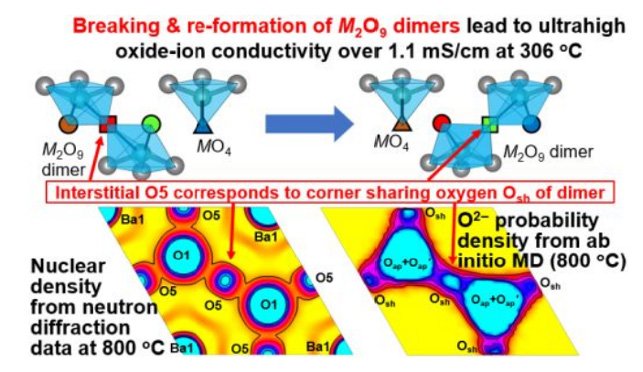Scientists at the Tokyo Institute of Technology (Tokyo Tech), in collaboration with Tohoku University and others, have investigated a unique and promising material for next-generation electrochemical devices: hexagonal perovskite-related oxide Ba7Nb3.8Mo1.2O20.1. They unveiled the material's unique ion-transport mechanisms, something that will pave the way for better dual-ion conductors and a greener future.
Clean energy technologies are the cornerstone of sustainable societies, and solid-oxide fuel cells (SOFCs) and proton ceramic fuel cells (PCFCs) are among the most promising types of electrochemical devices for green power generation. These devices, however, still face challenges that hinder their development and adoption.
Ideally, SOFCs should operate at low temperatures to prevent unwanted chemical reactions from degrading their constituent materials. Unfortunately, most known oxide-ion conductors, a key component of SOFCs, only exhibit decent ionic conductivity at elevated temperatures. As for PCFCs, not only are they chemically unstable under carbon dioxide atmospheres, but they also require energy-intensive, high-temperature processing steps during manufacturing.
Dual-ion conductors, however, offer a solution to these problems. By facilitating the diffusion of both protons and oxide ions, these conductors can achieve high total conductivity at lower temperatures, thereby improving the performance of electrochemical devices. Still, the underlying conducting mechanisms behind this material remain poorly understood.
Against this backdrop, a research team led by Professor Masatomo Yashima from Tokyo Tech, decided to investigate the conductivity of materials similar to Ba7Nb4MoO20 but with a higher ration of molybdenum (Ba7Nb4-xMo1+xO20+x/2). Their latest study, which was conducted in collaboration with the Australian Nuclear Science and Technology Organisation (ANSTO), the High Energy Accelerator Research Organization (KEK), and Tohoku University, was published in Chemistry of Materials on November 14, 2023.
After screening various compositions of Ba7Nb4-xMo1+xO20+x/2, the team found Ba7Nb3.8Mo1.2O20.1 to have remarkable proton and oxide-ion conductivities. "We discovered that Ba7Nb3.8Mo1.2O20.1 exhibited bulk conductivities of 11 mS/cm at 537 °C under wet air and 10 mS/cm at 593 °C under dry air, points out Yashima. "The total direct current conductivity at 400 °C in wet air for Ba7Nb3.8Mo1.2O20.1 was 13 times higher than that of Ba7Nb4MoO20, and the bulk conductivity in dry air at 306 °C is 175 times higher than conventional yttria-stabilized zirconia (YSZ) - a ceramic material commonly used as an electrolyte in SOFCs."
To shed light on the underlying mechanisms behind these high conductivity values, Yashima and his colleagues then conducted ab initio molecular dynamics (AIMD) simulations, neutron diffraction experiments, and neutron scattering length density analyses. This enabled them to study the structure of Ba7Nb3.8Mo1.2O20.1 in greater detail and determine what makes it special as a dual-ion conductor.
They discovered that the high oxide-ion conductivity of the material originates from a unique phenomenon. Adjacent (Nb/Mo)O5 monomers in Ba7Nb3.8Mo1.2O20.1 can form M2O9 dimers by sharing an oxygen atom at one of their corners (M = Nb/Mo cation). Much like a long line of people relaying a bucket of water can accelerate its transportation, the breaking and reforming of these dimers gives rise to ultrafast oxide-ion movement. Furthermore, the AIMD simulations revealed that the observed high proton conduction arose from efficient proton migration in the hexagonal, tightly-packed BaO3 layers in the material.
Taken together, the results of this study highlight the potential of perovskite-related dual-ion conductors and could serve as guidelines for the rational design of these materials. "Uncovering the high conductivities and unique ion migration mechanisms in Ba7Nb3.8Mo1.2O20.1 will help push the engineering of oxide-ion, proton, and dual-ion conductors, leading us to even better conducting materials for next-generation energy technologies," concludes a hopeful Yashima.

- Publication Details:
Title: Dimer-Mediated Cooperative Mechanism of Ultrafast-Ion Conduction in Hexagonal Perovskite-Related Oxides
Authors: Yuichi Sakuda, Taito Murakami, Maxim Avdeev, Kotaro Fujii, Yuta Yasui, James R. Hester, Masato Hagihala, Yoichi Ikeda, Yusuke Nambu, and Masatomo Yashima
Journal: Chemistry of Materials
DOI: 10.1021/acs.chemmater.3c02378
Contact:
Public Relations Division
Tokyo Institute of Technology
Email: media jim.titech.ac.jp
jim.titech.ac.jp


